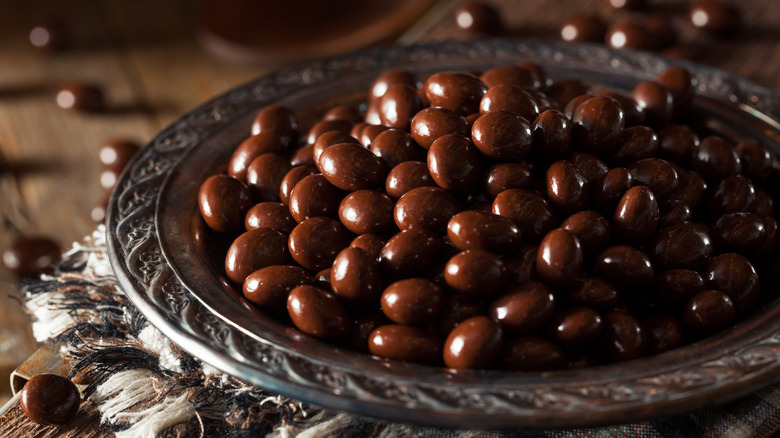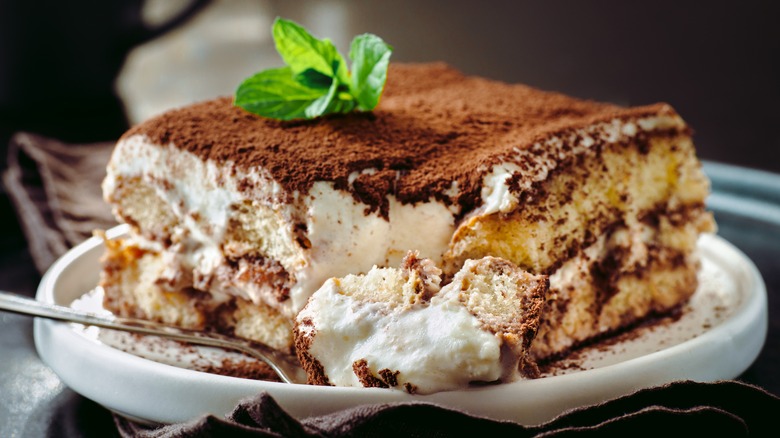How Much Caffeine Is In Chocolate Covered Espresso Beans?
It can be easy to forget that chocolate covered espresso beans actually contain caffeine. They're a delicious treat that tastes pretty far from your morning cup of joe, after all. That being said, they are actually the same espresso beans from which coffee is roasted, and, as such, they naturally contain some stimulants. So, the next time you're considering eating a few late at night, it might be best to know just how much caffeine you'll be ingesting first.
To begin, as a baseline, the USDA states that an average cup of coffee contains about 80-100 mg of caffeine. But, the amount in each chocolate covered bean depends largely on the brand that you're eating. For example, Taza espresso beans contain about 3.75 mg per individual bean. With that amount, you'd need to ingest 21 of them to have the equivalent of a cup of coffee.
Taza's is on the lower end of the caffeine spectrum, however. Other options, such as L'orenta espresso beans, can vary from 7-13 mg of caffeine. At the highest end of that range, a mere six beans would be the same as a full serving of coffee.
Decaf options do exist
If you are caffeine sensitive, or if you'd just prefer to have some chocolate covered espresso beans without a jolt, you might want to seek out a decaf alternative. Fortunately, there are several options on the market. Though, you'll want to keep in mind that decaf coffee still contains trace amounts of caffeine.
Per the USDA, decaf coffee must have at least 97% of its caffeine content removed. There are a number of ways this is accomplished. The Swiss Water Process, an all-natural method that has become popular among craft roasters, is able to remove 99.9% of a bean's caffeine amounts. If you want espresso beans with the absolute least amount of stimulants in them, seek out ones that are decaffeinated using this method.
In general, though, it's safe to assume that a standard cup of decaf coffee contains about 2-3 mg of caffeine. This should translate to very little per decaf espresso bean, but what constitutes a small amount is a personal decision that will depend on your own relationship with caffeine.
What about other caffeinated desserts?
Chocolate covered espresso beans aren't the only dessert with caffeinated ingredients. Coffee or espresso ice cream may jump to mind. The actual caffeine content per serving will — as you may guess — depend on the brand. Some options, such as Ben & Jerry's Coffee Coffee BuzzBuzzBuzz, contains as much as 45 mg of caffeine per half-cup serving. This means that eating a full cup will be equivalent to a standard cup of coffee. Other versions, such as Talenti's Coffee Cookie Crumble, only contains 14 – 29 mg of caffeine per 2/3 cup serving.
Coffee and dessert also combine in tiramisu, which can contain anywhere from 2/3 cup to over 2 cups of espresso or coffee in a whole dish. Here, ladyfingers are briefly dunked in a coffee mixture before being layered with mascarpone and other ingredients. Just how long they're dipped affects the caffeine content; the more time they spend marinating, the more caffeine they soak up. Similarly, the roast that you use for the task will also have an effect. If you use an extra caffeinated espresso or a buzzy light roast, and your dessert will have more of a kick.



